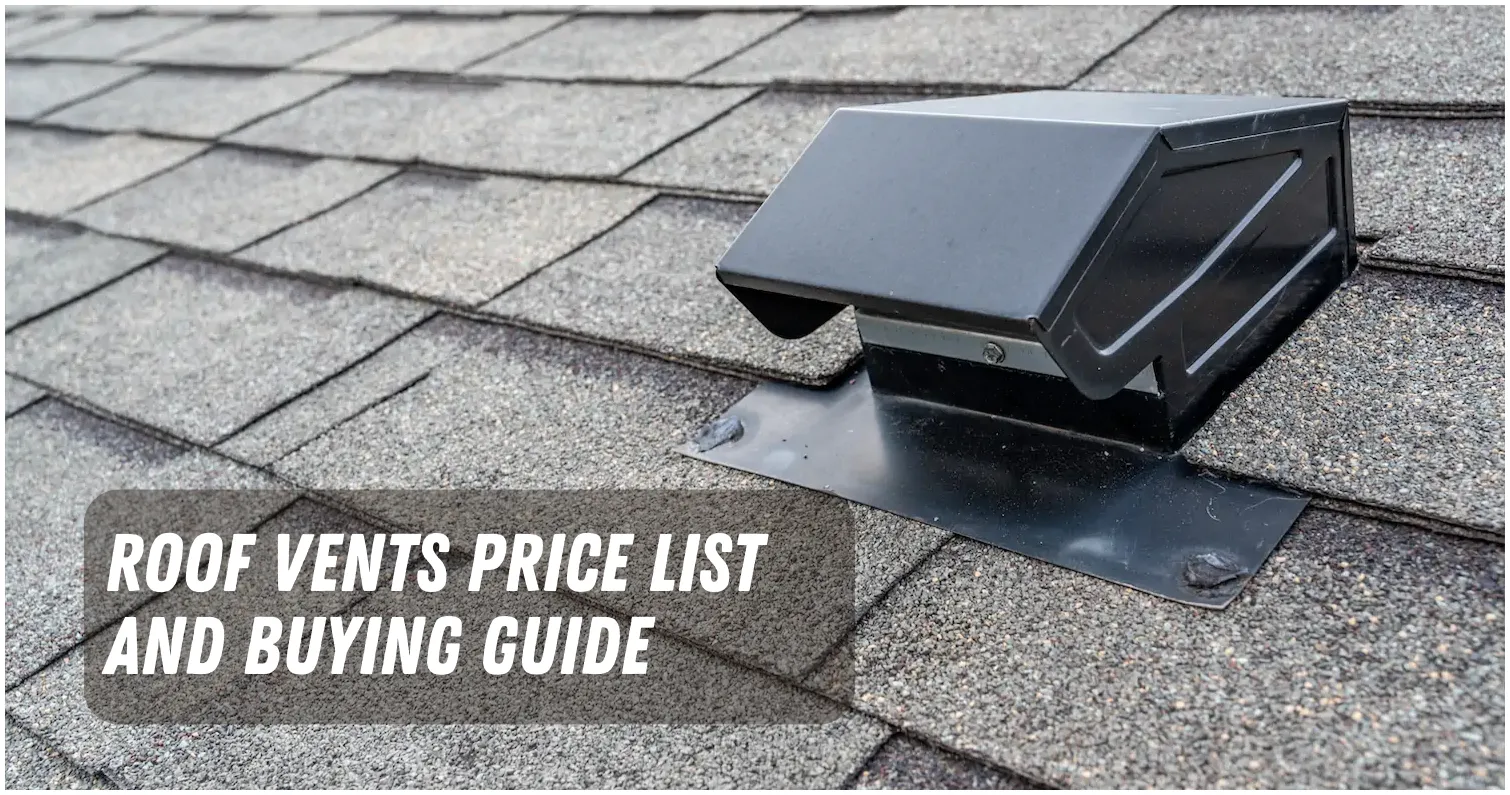As a homeowner, you might be thinking about installing roof vents to improve your home’s ventilation and overall comfort for a low price.
These devices help the air flow in your attic, which helps reduce heat, moisture, and smells.
Also, roof vents are a cheap way to save energy and can add years to the life of your roof for only ₱500 to ₱12,000
This in-depth guide aims to clarify roof vents, their purpose, the various types available, their advantages, and the price range of roof vents in the Philippines.
What is Roof Vents

Roof vents are openings or devices that are installed on the roof or near the ridge of the roof to allow air to flow in and out of the attic space. Roof vents can be passive or active.
Passive roof vents rely on natural convection or wind to create air movement, while active roof vents use fans or turbines to force air in or out.
Roof Vents Uses
By introducing roof vents, you’ll enjoy several perks:
- Mitigation of heat accumulation in the attic, enhancing home comfort and slashing cooling expenses.
- Prevention of attic moisture build-up, averting potential damage to insulation, wiring, roofing materials, and risks of mold, mildew, and rust.
- Improvement of indoor air quality through the expulsion of attic-based odors, pollutants, and allergens.
- Protection against ice dams that result from snow thawing and re-freezing on the roof edge, thus blocking proper water drainage.
Type of Roof Vents

The market offers a variety of roof vents, each possessing unique pros and cons. Some prevalent types include:
- Ridge vents:
These narrow, long vents run along the roof peak, providing a continuous opening for hot attic air to escape. Typically used alongside soffit vents, they offer effective, discreet, and weather-resistant ventilation. - Gable vents:
Installed on the roof’s gable ends, these triangular or rectangular vents permit airflow through the gable walls. They boast easy installation and various designs, but might not offer sufficient ventilation without wind. - Soffit vents:
These minor vents underneath the roof eaves permit fresh outside air into the attic. Essential for a balanced ventilation system, they are inexpensive but may get blocked by dust or insulation if not properly maintained. - Turbine vents:
Dome-shaped with spinning blades, these vents create a suction effect, pulling hot attic air out and allowing cooler external air in when wind blows. Despite their easy installation and zero power consumption, their performance may falter without wind or during heavy rain or snow. - Power vents:
Using solar power or electricity, these fans fitted on or near the roof ridge forcefully expel hot attic air and draw in fresh air. Though efficient and adjustable, they may consume power, be noisy, break down, or pose fire hazards if improperly wired.
Roof Vents Price List

The price of roof vents depends on various factors such as the type, size, material, quality, brand, installation, and maintenance of the vent.
The following table provides a rough estimate of the average cost of different types of roof vents in Philippines:
| Type of Roof Vent | Average Cost |
|---|---|
| Box vent | ₱500 – ₱1,000 |
| Soffit vent | ₱500 – ₱1,000 |
| Gable vent | ₱1,000 – ₱2,000 |
| Ridge vent | ₱1,000 – ₱2,000 |
| Turbine vent | ₱1,500 – ₱3,000 |
| Electric fan | ₱2,000 – ₱5,000 |
| Ridge vent fan | ₱3,000 – ₱6,000 |
| Solar fan | ₱5,000 – ₱10,000 |
| Solar ridge vent | ₱6,000 – ₱12,000 |
Note: The prices are based on online sources and may vary depending on the actual market conditions.
Roof Vents Pros and Cons
Before purchasing roof vents, weigh their pros and cons:
Pros:
- They boost your home’s ventilation and comfort by alleviating attic heat, moisture, and odors.
- They offer energy and cost savings while enhancing your roof’s longevity.
- They improve indoor air quality by eradicating attic-based allergens and pollutants.
- They guard against ice dams that can cause water leaks and damage.
Cons:
- They may underperform if not well-sized, installed, or balanced, thus providing inadequate ventilation.
- Over time, they may clog, leak, or get damaged, necessitating regular maintenance and repair.
- They could create noise, vibrations, or fire hazards, depending on their type and quality.
- They might compromise your roof’s aesthetic appeal depending on their design and color.
Roof Vents Alternatives
Should roof vents fail to meet your expectations, consider these alternatives:
- Attic fans:
Installed inside the attic or on the ceiling below, these fans extract hot attic air and push it outside via a vent. Although efficient and easy to install, they might consume power, be noisy, or cause negative attic pressure if not well-balanced with intake vents. - Skylights:
These roof or near-ridge roof windows allow natural light and fresh air into the attic. Despite their aesthetic appeal and energy efficiency, they might be costly, challenging to install, or prone to leaks if not adequately sealed. - Solar tubes:
Installed on or near the roof ridge, these tubes capture sunlight and reflect it into the attic. Although affordable and eco-friendly, they may not offer sufficient attic ventilation or illumination.
Thing You Should Know about Roof Vents
Here are some common questions and answers about roof vents:
- What type of roof vent is most effective?
The most effective type of roof vent varies depending on factors such as house design, climate, and personal preference. A combination of different vents, like ridge vents and soffit vents, can provide optimal attic ventilation. - Why do you need air vents?
Air vents are necessary to maintain a comfortable and healthy indoor environment by regulating temperature and humidity levels. They also prevent damage to the house structure by preventing heat buildup and moisture accumulation. - Do roof vents reduce heat?
Roof vents can reduce heat in the attic by allowing hot air to escape and cool air to enter. However, other factors like roof color, insulation, and shading also influence attic heat levels. - Why is it important to vent your roof for ventilation?
Venting the roof is essential to prevent issues like mold, mildew, rot, ice dams, and heat damage, ensuring a healthy living environment and prolonging roof life. It also improves energy efficiency and comfort by reducing cooling and heating costs. - Is vented roof better?
Yes, a vented roof is generally better than an unvented roof as it provides adequate attic ventilation, preventing issues like mold, mildew, and heat damage while improving energy efficiency and comfort.
In conclusion, roof vents are an effective solution for improving the ventilation and overall comfort of your home.
In terms of the roof vents price in the Philippines, the cost will depend on various factors such as the vent type, size, installation fees, and the specific conditions of your roof.
It’s essential to do thorough market research, consider alternatives, and balance the investment with the long-term energy savings and extended lifespan of your roof.
[ratings]

